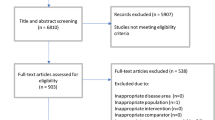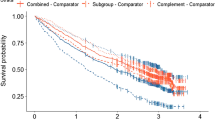Abstract
There is a framework providing some general guidance to interpret the levels of parameter uncertainty of the probabilistic analysis in economic evaluations. Given that this framework may not fully address underlying causes for the uncertainty, we sought to extend it for two specific scenarios. We provided the mathematical interpretations and conducted simulation studies for two scenarios. The first study examined a case where the intervention and control strategies were associated with different health states (e.g., active surveillance versus surgery for treatment of non-invasive cancer). The second study evaluated the quality-adjusted life-years (QALYs), estimated from reported summary statistics (i.e., mean and standard deviation) of longitudinal post-treatment utility data from a clinical trial. The first simulation study showed that the magnitude of uncertainty of cost-effectiveness results was much greater if a decision model considered different health states for the intervention and control strategies than if the model considered the same health states. The second study showed that variance in the estimates of QALYs and incremental QALYs using the summary statistics was substantially underestimated when the correlations of repeated measures which are generally not available in the literature were omitted. We further discussed the implications of our findings for the economic modeling. In addition to qualitative categorization of uncertainty proposed by the general framework to assist with decision-making, we also need to comprehend methods used to address uncertainty in economic evaluations to enable informed policy making.

Similar content being viewed by others
Data availability statement
Data analyzed in this study were the simulated data using SAS software. The SAS code is available upon request.
References
Briggs A, Sculpher M, Claxton K (2006) Decision modelling for health economic evaluation. Oxford University Press, Oxford
Briggs AH, Weinstein MC, Fenwick EA, Karnon J, Sculpher MJ, Paltiel AD, Force I-SMGRPT (2012) Model parameter estimation and uncertainty: a report of the ISPOR-SMDM modeling good research practices task force-6. Value Health 15(6):835–842. https://doi.org/10.1016/j.jval.2012.04.014
Canadian Agency for Drugs and Technologies in Health (2017) Guidelines for the economic evaluation of health technologies: Canada. Ottawa (ON): The Agency. https://www.cadth.ca/sites/default/files/pdf/guidelines_for_the_economic_evaluation_of_health_technologies_canada_4th_ed.pdf. Accessed 10 Nov 2022.
Degeling K, IJzerman MJ, Koopman M, Koffijberg H (2017) Accounting for parameter uncertainty in the definition of parametric distributions used to describe individual patient variation in health economic models. BMC Med Res Methodol 17(1):170. https://doi.org/10.1186/s12874-017-0437-y
Di Tanna GL, Porter JK, Lipton RB, Hatswell AJ, Sapra S, Villa G (2019) Longitudinal assessment of utilities in patients with migraine: an analysis of erenumab randomized controlled trials. Health Qual Life Outcomes 17(1):171. https://doi.org/10.1186/s12955-019-1242-6
Foteff C, Kennedy S, Milton AH, Deger M, Payk F, Sanderson G (2016) Cost-utility analysis of cochlear implantation in Australian adults. Otol Neurotol 37(5):454–461. https://doi.org/10.1097/MAO.0000000000000999
Gumbie M, Olin E, Parkinson B, Bowman R, Cutler H (2021) The cost-effectiveness of Cochlear implants in Swedish adults. BMC Health Serv Res 21(1):319. https://doi.org/10.1186/s12913-021-06271-0
Hansson E, Hagberg K, Cawson M, Brodtkorb TH (2018) Patients with unilateral transfemoral amputation treated with a percutaneous osseointegrated prosthesis: a cost-effectiveness analysis. Bone Jt J 100-B(4):527–534. https://doi.org/10.1302/0301-620X.100B4.BJJ-2017-0968.R1
Haymart MR, Miller DC, Hawley ST (2017) Active surveillance for low-risk cancers—a viable solution to overtreatment? N Engl J Med 377(3):203–206. https://doi.org/10.1056/NEJMp1703787
Health Quality Ontario (2016) Retinal prosthesis system for advanced retinitis pigmentosa: a health technology assessment. Ontario Health Technol Assess Ser 16(14):1–63
Health Quality Ontario (2018) Bilateral cochlear implantation: a health technology assessment. Ontario Health Technol Assess Ser 18(6):1–139
Houten R, Fleeman N, Kotas E, Boland A, Lambe T, Duarte R (2021) A systematic review of health state utility values for thyroid cancer. Qual Life Res 30(3):675–702. https://doi.org/10.1007/s11136-020-02676-2
Kharroubi SA, Beyh Y, Abdul Fattah E, Young T (2020) The importance of accounting for parameter uncertainty in SF-6D value sets and its impact on studies that use the SF-6D to measure health utility. Int J Environ Res Public Health. https://doi.org/10.3390/ijerph17113949
Krahn M, Miller F, Bayoumi A, Brooker AS, Wagner F, Winsor S, Dhalla I (2018) Development of the Ontario decision framework: a values based framework for health technology assessment. Int J Technol Assess Health Care 34(3):290–299. https://doi.org/10.1017/S0266462318000235
Magnus A, Isaranuwatchai W, Mihalopoulos C, Brown V, Carter R (2019) A systematic review and meta-analysis of prostate cancer utility values of patients and partners between 2007 and 2016. MDM Policy Pract 4(1):2381468319852332. https://doi.org/10.1177/2381468319852332
National Institute for Health and Care Excellence (2012) Methods for the development of NICE public health guidance, 3rd edn. The Institute. https://www.nice.org.uk/process/pmg4/chapter/appendix-i-quality-appraisal-checklist-economic-evaluations. Accessed 10 Nov 2022.
Ontario Health (2020) Implantable devices for single-sided deafness and conductive or mixed hearing loss: a health technology assessment. Ontario Health Technol Assess Ser 20(1):1–165
Ontario Health (2022) Molecular testing for thyroid nodules of indeterminate cytology: a health technology assessment. Ontario Health Technol Assess Ser 22(2):1–111
Pullenayegum EM, Chan KK, Xie F (2016) Quantifying parameter uncertainty in EQ-5D-3L value sets and its impact on studies that use the EQ-5D-3L to measure health utility: a bayesian approach. Med Decis Mak 36(2):223–233. https://doi.org/10.1177/0272989X15591966
Richards DA, Ekers D, McMillan D, Taylor RS, Byford S, Warren FC, Finning K (2016) Cost and outcome of behavioural activation versus cognitive behavioural therapy for depression (COBRA): a randomised, controlled, non-inferiority trial. Lancet 388(10047):871–880. https://doi.org/10.1016/S0140-6736(16)31140-0
Wicklin R (2013) Simulating data with SAS. SAS Institute Inc, Cary
Xie X, Yeung MW, Wang Z, Wang M, Gajic-Veljanoski O, Ng V, Volodin A (2020) Comparison of the expected rewards between probabilistic and deterministic analyses in a Markov model. Expert Rev Pharmacoecon Outcomes Res 20(2):169–175. https://doi.org/10.1080/14737167.2019.1615886
Xie X, Schaink AK, Liu S, Wang M, Volodin A (2022) Understanding bias in probabilistic analysis in model-based health economic evaluation. Eur J Health Econ. https://doi.org/10.1007/s10198-022-01472-8
Acknowledgements
Dr. Wendy J. Ungar holds a Canada Research Chair in Economic Evaluation and Technology Assessment in Child Health. We would like to thank Ms. Nancy Sikich (Director of Health Technology Assessment Program, Ontario Health, Toronto, Canada) and Dr. Eleanor Pullenayegum (Senior Scientist of the Hospital for Sick Children, Toronto, Canada) for their constructive comments and suggestions.
Funding
None.
Author information
Authors and Affiliations
Corresponding author
Ethics declarations
Conflict of interest
All authors declare that they have no conflict of interest.
Code availability
The SAS code for generating and analyzing the data is available upon request.
Disclaimer
The opinions expressed in this publication do not necessarily represent the opinions of Ontario Health. No endorsement is intended or should be inferred.
Additional information
Publisher's Note
Springer Nature remains neutral with regard to jurisdictional claims in published maps and institutional affiliations.
Supplementary Information
Below is the link to the electronic supplementary material.
Rights and permissions
About this article
Cite this article
Xie, X., Gajic-Veljanoski, O., Ungar, W.J. et al. Modeling methods and the degree of parameter uncertainty in probabilistic analyses of economic evaluations. Netw Model Anal Health Inform Bioinforma 12, 9 (2023). https://doi.org/10.1007/s13721-022-00404-z
Received:
Revised:
Accepted:
Published:
DOI: https://doi.org/10.1007/s13721-022-00404-z




